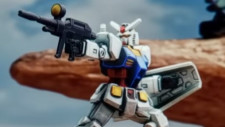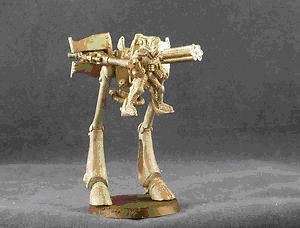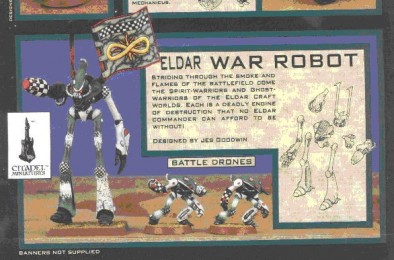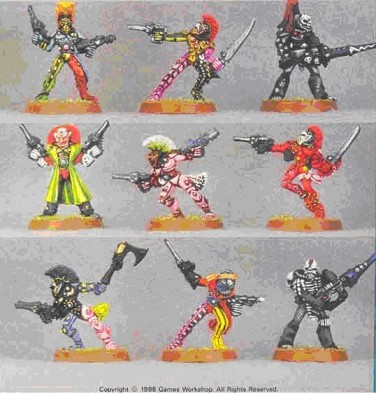From Empire To Fall: The Development Of The Eldar Part 2
June 20, 2013 by crew
Two years after the release of the Rogue Trader 40,000 rulebook and the Eldar were comprised of little more than traders and piratical corsair bands aiding or attacking the Imperium as the whim took them. As models were produced that expanded the forces at the Eldar player’s disposal so did the accompanying rules find their way into White Dwarf.
In 1989 Games Workshop released ‘Warhammer 40,000 The Compendium’ which collected these articles together. Within the pages were units that are still in Eldar army lists today, if perhaps in another guise.
Vehicles
Plastic vehicle kits were expensive to produce. The majority of vehicle models were made of metal with only three plastic kits available during the rogue trader era. These were the Imperial Land Raider, Rhino and Ork Battlewagon. The Eldar would have to wait until 1997 before the release of their first plastic vehicle with the Falcon Grav-Tank.
Warwalkers were billed as a development of Eldar Dreadnought technology. Like all other dreadnoughts from this time the Eldar Dreadnought was crewed by a living pilot who even had the option of ejecting when things got bad! The Warwalker followed this principle but was a light support suit of dreadnought armour that sacrificed heavy armour for speed. The pilot’s cockpit was open to the elements but was protected by three power fields that would lessen the amount of damage caused by hits. Though this feature would change over time it is still a part of the Warwalkers design to this day.
With the coming of the Warwalker came the scatter laser. The Eldar have ever been the foremost masters of laser technology and whether it be the lasblaster wielded by Corsairs and Swooping Hawks or the bright lances used for busting open tanks the Eldar have always had the edge on their enemies. The scatter laser had the ability to shoot six high powered shots that could spell doom for infantry or light vehicles and a high rate of fire is still what sees it blazing lasery death across gaming boards today.
The Infinity Circuit was introduced as the Eldar version of a computer. Eldar memory engrams would be uploaded to an infinity circuit which could only accommodate a single consciousness. This process would leave the Eldar’s body so only those near death would undergo the procedure of Soul-grafting. This was seen as the ultimate sacrifice that an Eldar could make in the service of their clan. They would be doomed to eternal life as an unfeeling thing of steel. Only the mightiest of Eldar could expect to survive the procedure without being driven insane and those that did survive were highly venerated, being given the title of Lord Phoenix.
The practical application of infinity circuits in the game was as pilots for Spirit and Ghost Warriors. Spirit Warriors were similar to Dreadnoughts except that their pilot was technically dead rather than living. They were based upon the Dreadnought model with a replacement head that even back then looked comically small for its frame. You even had the option to upgrade them to psykers making them even more formidable. Ghost Warriors were smaller constructs who specialised in infiltration and sabotage. Composed of a material called Stelthene they were invisible to all but the naked eye. With a host of extra rules Ghost Warriors would cause nothing but grief for your opponent.
Of course the Infinity Circuit would go on to play a far more central role in Eldar lore and Spirit Warriors would eventually replace crewed dreadnoughts altogether. Ghost Warriors would evolve into the Wraithguard though they would move away from being robot assassins. Armies across the Milky Way breathe a sigh of relief that shrouded multiple attack 2 wound Wraithguard are not marching towards their battle lines in the modern era.
Dealing Death With a Smile
Perhaps the biggest event in early Eldar development to date was the coming of the Harlequins. Flamboyant and deadly these Eldar are followers of the Great Harlequin Cegorach. To the Harlequins there is no difference between art and war and they perform both to perfection. Tumbling and pirouetting across their chosen stage be it Craftworld audience chamber or alien battlefield they dealt out comedy, tragedy or death with ease. The arrival of the Harlequins also brought with it the next step in established Eldar lore, the Fall.
When a troupe of Harlequins arrives at a Craftworld they may perform The Dance Without End. The entire troupe will take part in this performance. It tells of the Eldar’s rise to mastery of the galaxy and their fall that would nearly wipe them from existence and create that which will forever be their greatest enemy, the Chaos God Slaanesh. The bulk of the roles were played by the Troupers and Mimes. Like all Harlequins they wear masks that during performances take on the aspect of those they play whilst in battle they will constantly shift, reflecting terrors torn from the minds of their foes.
The role of Death is played by the Death Jesters, heavy weapon specialists who strike from afar with mighty weapons. The Avatar, leader of the troupe, plays Cegorach the Great Harlequin who battles Slaanesh. The role of Slaanesh is played by the Solitaire, a lonely and cursed individual whose soul is forfeit to the God of Pleasure upon their death unless Cegorach can fool it from Slaanesh’s grasp.
The Harlequins were also guardians of the secret webway routes. Developed by the old Slaan, the Eldar had inherited and developed the webway as a means to travel their vast intergalactic empire. Though now in a state of disrepair the webway still performs the vital purpose of linking the disparate parts of the Eldar race. Deep within the webway the Black Library is hidden. A repository of the Eldar’s knowledge and every dark secret they had learned of Chaos. Such an iconic location still forms the basis of many quests both fair and foul in the 41st Millenium.
In battle the Harlequins dance towards their enemy clad in a variety of unique wargear such as the geirgilath or flip belt which allows them to pivot at hip level so they can make full use of their acrobatic talents. They also wear a dathedi shield which means ‘between colours’, a personal holo-field making them harder to hit. Once a Harlequin gets within striking distance they would strike with their hrathu-angau, the harlequin’s kiss. A graceful looking tube mounted on the forearm that would be punched into the body of an opponent. From the tip would unravel monofilament wire that would thrash around inside the foe turning their insides to soup.
The Harlequins were like nothing seen before in the 40k universe and they became instantly popular. Quality miniature painting was still in its infancy in 1989 with a great deal of the techniques taken for granted now being refined. Harlequins proved fertile ground for budding artists to work on intricate and colourful styles, working a level of detail into their work that would see these miniatures go through to the top rankings in many painting competitions.
Their inspiration likely comes from Arlecchino, a harlequin character featured in opera who whilst gluttonous and stupid was extremely nimble and athletic. He would take any opportunity to woo a woman for himself if desired by another and would interrupt or ridiculing a rival suitor. You can see how these characteristics could be applied to the Eldar Harlequins and the Great Harlequin in particular.
Up until this point the main influence in Eldar lore had been typical elven archetypes with a sprinkling of Celtic names but that was to change when a young Jes Goodwin took a holiday abroad and that will be the starting point of our next article.
Lee Trayler
Supported by (Turn Off)
Supported by (Turn Off)
Supported by (Turn Off)















































































Loving your articles and giving fond memories of when I first saw these models as a school boy.
Its explains why I am still a Eldar player all these years now 🙂
These are some great articles looking forward to similar ones in the future.
Bring on tomorrows instalment.
Next installment will be coming on Monday 🙂
Great stuff….managed to dig out my “Vintage Models” from the shed…forgot I had one of those robots. Looks like I’d painted it up like a Harlequin! One of the nice things about the early harlequins was the extensive list of weapon options. Havn’t got my copy of the new codex yet….how limited wrt options are they now?
This is a great slice of nostalgia. Excellent writing.
The Vyper came before the Falcon, if I am not totally wrong. But still great article.
That is an interesting point you raise. The Vyper was the first new vehicle kit for a long time but prior to its release all the Vyper models that we saw were conversions of the regular jetbike. To this day I still consider the Vyper Jetbike to be a jetbike and you can find me grumbling under my breath during games at times that they cannot turbo boost. It has been a personal thing that I don’t consider jetbikes vehicles as such because for so many editions now they have been a special type of infantry but back in the… Read more »
Another thumbs up.
RT quin armies where points expensive 250pts basic for 6 troops as apposed to 250 for 10 man marine tac squad. more so for 35pts you could make every troupes avatar a lvl 1psyker. I only used them as allies ( 1 troupe max) as they where a lot of work to use. their main protection was their difficulty to actually hit (-to hit rolls being a main rule mechanic) but if they where hit it usually ment splat. Of interest the army list for Harlequins was printed in WD (105 fluff and 106 list) long before normal elder got… Read more »